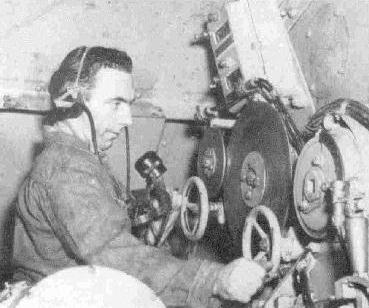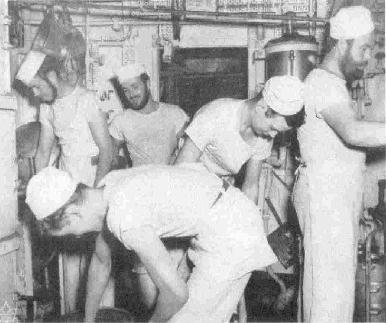From Crowsnest Magazine
![]()
![]()
When Action Alarm Sounds, Cooks, Stewards Double to Combat Posts
WITH THE CANADIAN DESTROYERS IN THE FAR EAST - Cooks and stewards have to be a versatile group in a destroyer at sea during wartime. Not only do they have their regular duties to perform but they must double up as members of the guns' crews or ammunition supply teams during a bombardment or "action stations".Using HMCS NOOTKA as an example, we find the cooks and stewards first have their routine duties to perform, such as preparing, cooking and serving food to a crew of 265. This includes roasting, grilling or frying meats, preparing salads, cooking vegetables and baking pies, cakes rolls and bread. Bread making presents its own difficulties during a bombardment. As the dough is set to rise, the guns may commence firing with the result that he dough falls flat - a disheartening experience for a baker at any time.
 |
His duties in the galley took second place for PO Donald Dockrill of Halifax, one of NOOTKA's cooks during the destroyer's busy patrol off the coast of Korea May 19 to June 4, 1951. The NOOTKA was extensively employed on bombardment operations which meant that Dockrill, being a member of one of the four-inch guns' crews, saw comparatively little of the galley. He was the sight-setter and communications number at the gun. (RCN Photo NK-680)
Adding to their problems is the fact that in the middle of cooking a meal, "action stations" may sound and the majority must hurriedly desert the galley and pantries to head for the guns, leaving the final preparation to the one watch on duty. Finally, "action messing" is instituted and one man is spared from each of the guns and action stations, but only to pick up the food and take it back to the men at their various posts. A typical dinner which the cooks may prepare for the ship's company includes cream of vegetable soup, grilled steaks, grilled onions, mashed potatoes, Swiss chard, coconut cream pie, bread, butter and a choice of tea, coffee or milk.Preparation of a meal in a destroyer is considerably different from cooking in the spacious galleys to be found in shore establishments. Although the galley equipment, which includes oil fuel ranges, electric bake ovens, stove cookers, machine mixers, slicer and potato peeler etc., is adequate to cope with the catering requirements of the ship's company, the working space is limited, as a destroyer must be built to allow the maximum striking power for a ship of her size. The free working area is little more than the average housewife his in her own kitchen. However, by organizing the cooks' and stewards' duties and with proper menu planning and timing, meals for 265 persons are prepared , cooked and served without any major difficulties.
 |
Some people maintain that the ship's cook is the most important man aboard. One of the first things he has to learn is how to work efficiently in comparatively cramped and crowded quarters as illustrated in this photo taken in HMCS HURON's galley at the height of preparations for the noonday dinner. In the foreground, bending over a cauldron of soup, is AB George Aucoin of Marguerite N.S, and behind him, left to right are AB's Robert Hollas, Mimico, Ont; Bev Banks, Shelburne, N.S.; "Bud" Gehan, Tweed Ont; and PO Bill Clinton, Halifax. (RCN Photo HU-71)
Napoleon recognized the importance of cooks when he said "an army marches on its stomach". Just as important are the cooks at sea where the excitement of "action stations" and the rigors of life aboard a wartime destroyer, along with the fresh sea air, build up healthy appetites which, when well-catered to, help provide a happy ships' company.[Source: Crowsnest Magazine; Sept 1951; Vol 3 No 11]
|
|